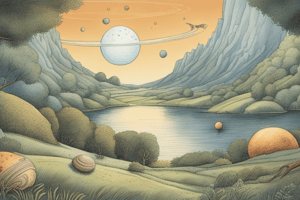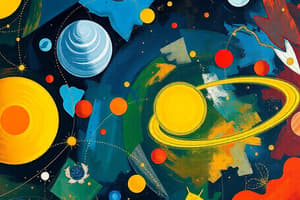Podcast
Questions and Answers
Which is the densest planet in the solar system?
Which is the densest planet in the solar system?
Earth
Rank the objects based on their average distance from the Sun, from farthest to closest: Pluto, Saturn, Jupiter, Mars, Earth, Mercury. The correct order is __________.
Rank the objects based on their average distance from the Sun, from farthest to closest: Pluto, Saturn, Jupiter, Mars, Earth, Mercury. The correct order is __________.
Pluto, Saturn, Jupiter, Mars, Earth, Mercury
Rank these objects based on their mass, from highest to lowest: Sun, Jupiter, Earth, Mars, Mercury, Pluto. The correct order is __________.
Rank these objects based on their mass, from highest to lowest: Sun, Jupiter, Earth, Mars, Mercury, Pluto. The correct order is __________.
Sun, Jupiter, Earth, Mars, Mercury, Pluto
Rank these objects by size (average equatorial radius), from largest to smallest: Sun, Jupiter, Earth, Mars, Mercury, Pluto. The correct order is __________.
Rank these objects by size (average equatorial radius), from largest to smallest: Sun, Jupiter, Earth, Mars, Mercury, Pluto. The correct order is __________.
Rank the planets based on their average surface (or cloud-top) temperature, from highest to lowest: Mercury, Earth, Mars, Jupiter, Neptune. The correct order is __________.
Rank the planets based on their average surface (or cloud-top) temperature, from highest to lowest: Mercury, Earth, Mars, Jupiter, Neptune. The correct order is __________.
Rank the planets based on the amount of time it takes them to orbit the Sun, from longest to shortest: Neptune, Jupiter, Mars, Earth, Mercury. The correct order is __________.
Rank the planets based on the amount of time it takes them to orbit the Sun, from longest to shortest: Neptune, Jupiter, Mars, Earth, Mercury. The correct order is __________.
Rank the planets based on the number of moons that orbit them, from highest to lowest: Jupiter, Mars, Earth, Mercury. The correct order is __________.
Rank the planets based on the number of moons that orbit them, from highest to lowest: Jupiter, Mars, Earth, Mercury. The correct order is __________.
Where would you expect to find terrestrial planets in a planetary system?
Where would you expect to find terrestrial planets in a planetary system?
Compared to terrestrial planets, jovian planets are __________.
Compared to terrestrial planets, jovian planets are __________.
Which planet is approximately halfway between Pluto's orbit and the Sun?
Which planet is approximately halfway between Pluto's orbit and the Sun?
How do Pluto and Eris differ from terrestrial and jovian planets in our solar system?
How do Pluto and Eris differ from terrestrial and jovian planets in our solar system?
Which planet has a rotational axis that is tilted so much it lies nearly in the plane of its orbit?
Which planet has a rotational axis that is tilted so much it lies nearly in the plane of its orbit?
Which planet is known to have the highest average surface temperature?
Which planet is known to have the highest average surface temperature?
What is the planet that orbits closest to the Sun?
What is the planet that orbits closest to the Sun?
What is the only rocky planet to have more than one moon?
What is the only rocky planet to have more than one moon?
Which jovian planet orbits closest to the Sun?
Which jovian planet orbits closest to the Sun?
Most of the surface of __________ is covered with liquid water.
Most of the surface of __________ is covered with liquid water.
Which planet is about 30 times as far from the Sun as our own planet?
Which planet is about 30 times as far from the Sun as our own planet?
What is the planet with the lowest average density?
What is the planet with the lowest average density?
Which of the following is not one of the four major features of the solar system?
Which of the following is not one of the four major features of the solar system?
Which of the following correctly describe patterns of motion in the solar system?
Which of the following correctly describe patterns of motion in the solar system?
Which of the following statements are true about the types of planets?
Which of the following statements are true about the types of planets?
Study Notes
Planetary Characteristics
- Earth is the densest planet in the solar system.
- Uranus has a uniquely tilted rotational axis, nearly lying in the plane of its orbit.
- Venus holds the title for the highest average surface temperature among planets.
- Mercury is the closest planet to the Sun, while Saturn has the lowest average density.
Distance from the Sun
- Objects in increasing proximity to the Sun rank as follows: Pluto, Saturn, Jupiter, Mars, Earth, Mercury.
- The planet Neptune orbits about 30 times farther from the Sun than Earth.
Mass and Size Rankings
- The ranking of solar system objects by mass, from highest to lowest: Sun, Jupiter, Earth, Mars, Mercury, Pluto.
- Size ranking (average equatorial radius) from largest to smallest: Sun, Jupiter, Earth, Mars, Mercury, Pluto.
Planetary Orbits and Temperatures
- Neptune takes the longest time to orbit the Sun, followed by Jupiter, Mars, Earth, and Mercury, which has the shortest orbital period.
- In terms of surface temperature ranking from highest to lowest: Mercury, Earth, Mars, Jupiter, Neptune.
Moons and Planets
- Jupiter has the most moons, with the order of planets by number of moons as follows: Jupiter, Mars, Earth, Mercury.
- Mars is unique as the only rocky planet with more than one moon.
Planet Types and Formation
- Terrestrial planets (like Earth and Mars) are expected to be found closer to their star compared to jovian planets (like Jupiter and Saturn).
- Compared to terrestrial planets, jovian planets are characterized by being more massive and having lower average densities.
Distinctions of Dwarf Planets
- The dwarf planets Pluto and Eris are smaller and less massive than terrestrial and jovian planets and travel in more elliptical orbits.
Solar System Structure
- The solar system is made up of eight major planets along with dwarf planets such as Ceres, Pluto, and Eris.
- Orderly motions in the solar system are characterized by planets closer to the Sun moving at higher speeds, nearly circular orbits, and orbits lying in the same plane.
Composition of Small Bodies
- Small bodies in the solar system are classified as asteroids when rocky and comets when icy, highlighting the diversity of solar system composition.
Studying That Suits You
Use AI to generate personalized quizzes and flashcards to suit your learning preferences.
Description
Test your knowledge of the solar system with these flashcards from ASTR111 MA7. Explore key concepts such as the densest planet and the ranking of solar system objects by distance from the Sun. Perfect for reinforcing your learning before exams.




